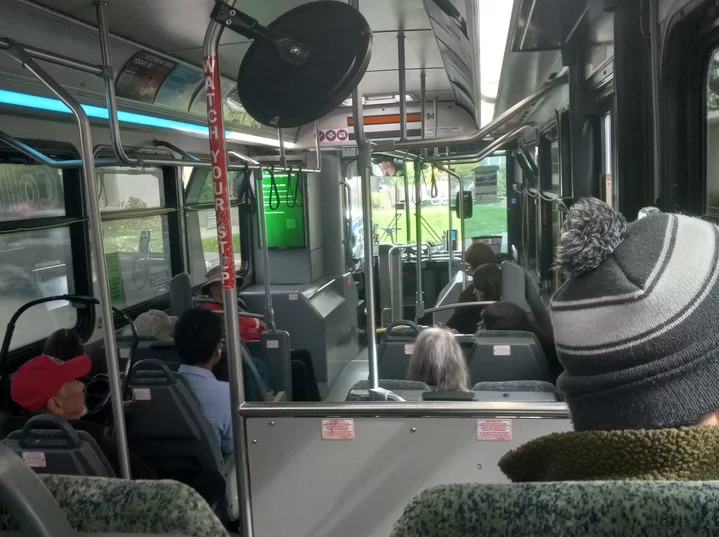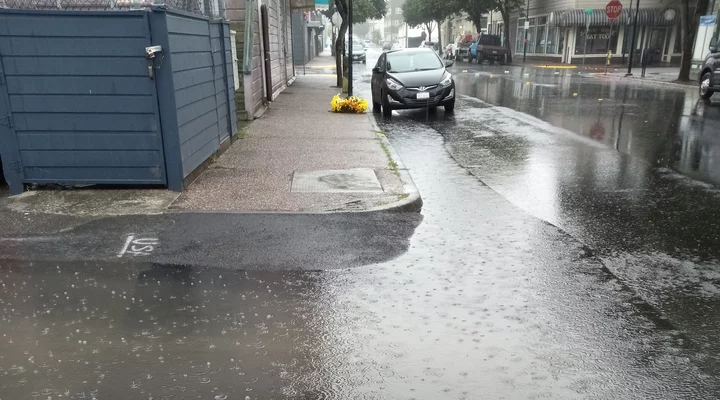The bus from Arcata to Trinidad. Photos: Colin Fiske.
I am a driver who tries to drive as little as possible. I have many motivations for reducing the miles I drive, including reducing my impact on the climate, reducing my risk of hurting or killing someone in a crash, getting more exercise, and getting to know my community better. Plus, to be honest, I just don’t like driving. I find it stressful and unpleasant.
I am lucky enough to live within walking or biking distance of most of my daily destinations, and near bus stops for the regional and Arcata transit systems. So most of the time, I really don’t drive very much. Most weeks for me are a week without driving.
But in spite of all that, I still have a driver’s license, the physical and financial ability to drive, and access to a vehicle (if my wife doesn’t need it more). When I want to do something that would be impossible or very inconvenient without a car, I drive. That’s a very different experience from someone who can’t drive at all. And it’s the reason I take my participation in the official Week Without Driving seriously.
At least 36,000 people in Humboldt County don’t have a driver’s license. That includes kids, of course, but also many seniors, people with disabilities, people who can’t afford a car, immigrants and others who face legal challenges, and a variety of other community members. There are also lots of people who do have a driver’s license but don’t drive, but we don’t know exactly how many.
For people who do currently drive, it can be hard to relate to the experience of being a nondriver. But if we live long enough, we will all become nondrivers eventually. Even if we do not end up with a disability that prevents us from driving, research suggests that older men live an average of 7 years after they stop driving, and women an average of 11 years. Many people likely would — and should — stop driving earlier if there were other good options for getting around. So even if the experiences of current nondrivers don’t move you, there are good reasons to care about this issue for your own sake.
Not ideal alternative transportation weather.
Today is the final day of the Week Without Driving. Throughout the week, local participants have reflected on their experiences in posts here on the Lost Coast Outpost, on social media, and in messages shared with CRTP. Many have identified challenges during the week, some of which have resulted in them choosing to drive. Here are some of the more common challenges, and some thoughts on what we might learn from them:
- Job demands. Probably the most common challenge faced by Week Without Driving participants is that their jobs require them to drive. These demands come in a variety of forms, from long commutes to workplaces that aren’t served by transit, to the need to transport large or heavy items, to expectations that employees get from one place to another so quickly that non-driving options are impossible. Facing these challenges during the Week Without Driving is an opportunity to reflect on what kinds of jobs nondrivers may be effectively excluded from — and whether that exclusion is really necessary. Many nondrivers want and need employment, but their options can be very limited. Can workplace cultures and norms be changed to allow participation by nondrivers?
- Time. Even outside of work, most of us lead busy lives, and we expect to pack a lot into every day. At the same time, we have developed low-density communities, with homes, jobs, and services spread far apart. This seems normal when you drive everywhere. But participants in the Week Without Driving are often confronted with the fact that those long distances translate into long travel times when driving is not an option. To better serve nondrivers, and reduce the overwhelming amount of time it can take to complete daily tasks, we will have to rethink the way we design our communities to address time pressures for people who aren’t driving.
- Grocery shopping. Many participants have found it hard to get their groceries home from the store without a car. But of course, nondrivers have to eat too! How do they get their groceries? How could we make it easier for nondrivers — and everyone else — to have convenient access to affordable, healthy food?
- Weather. In typical Humboldt fashion, the Week Without Driving started out with a big rainstorm this year. Participants in the Week Without Driving often reflect on how difficult or unpleasant it can be to walk or bike to work or to the bus stop in the rain. On the other hand, many participants reflect on how much easier it was than they expected — usually because they have good rain gear! Nondrivers, of course, don’t have the option to drive, which often means either getting wet or staying home when the storms roll in. Some have figured out tricks for staying relatively dry and comfortable in our rainy winters. But there’s a lot more we could do as a community — from better bus shelters to weather-protected bike parking — to make life a little more pleasant for nondrivers year-round.
For me, even though I regularly go weeks without driving, my participation in the official Week Without Driving over the last few years has highlighted another challenge. In a car-dependent community, driving can be not only a way to transport yourself, but a way to maintain social ties and support your community. This week, because I wasn’t driving, I couldn’t drive my wife to the airport (she could have taken the bus, but the schedule did not work well with her flights), and I couldn’t attend a community event that was difficult to reach without a car. I felt like I was failing in my responsibilities to other people. That made me reflect on the unsettling fact that we have built physical landscapes and cultural expectations that seem to make driving a prerequisite for being a full member of society.
In addition to the many challenges of getting around our communities without driving, Week Without Driving participants have also reflected on the benefits they enjoyed during the week. These include:
- Mental and physical health. Many Week Without Driving participants have commented on how much better they felt, both mentally and physically, when they got out of their cars and spent more time walking or biking.
- Time. All the extra time spent commuting or running errands without a car can feel like “wasted time” in our busy society. But many participants found that it provided them with valuable opportunities to exercise, reflect on the day, appreciate the scenery, or just relax (assuming they had a safe place to walk or bike!).
- Fun and freedom. If you’ve been stuck behind the wheel your whole adult life, you might forget how much fun life outside a car can be! Many Week Without Driving participants, especially those who spent more time biking, reflected on a newfound sense of freedom. Several said that they felt like a kid again!
- Community connections. Many participants noticed that buses and sidewalks are great places to meet new people and run into old friends. When you drive from one place to another, building and maintaining relationships usually takes conscious planning. Other modes of transportation can allow spontaneous, unplanned connections.
Getting a sense of the experiences of nondrivers can be truly eye-opening for Week Without Driving participants. That’s the main point of the event. But taken together, the challenges and benefits experienced by participants also highlight the fact that improvements that would benefit nondrivers — like more investment in public transportation, better sidewalks and crosswalks, safer bike lanes and trails — would benefit everyone else, too. Let’s stop seeing the world through our windshields and take a broader view.
###
Colin Fiske is the executive director of the Coalition for Responsible Transportation Priorities.
The national Week Without Driving runs from September 29 through October 5, 2025. It is an opportunity for participating public officials and other community members to get first-hand insights into the way many seniors, kids, people with disabilities, low-income people, and other non-drivers navigate our communities. Each day during the week, the Lost Coast Outpost is publishing reflections from local participants. For more information, visit this link.


CLICK TO MANAGE